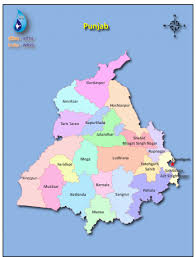
PUNJAB
Punjab: A Complete Overview
Punjab, located in the north-western part of India, is a state with rich cultural heritage, historical significance, and agricultural prosperity. It is often called the "Granary of India" due to its role in food production. The state has a fascinating mix of rural and urban areas, where agriculture is the backbone of the economy, and industries, especially textiles, have flourished in recent decades. Punjab is also home to a diverse population, predominantly Sikh, with Hindu and Muslim communities also contributing to its multicultural fabric.
Geography and Climate
Punjab is bordered by Haryana to the south, Himachal Pradesh to the east, Jammu & Kashmir to the north, and Pakistan to the west. The state has an area of about 50,362 square kilometers. Its geography is mostly flat, with fertile plains formed by the rivers Sutlej, Beas, and Ravi, making it one of the most agriculturally rich regions in India.
The climate of Punjab varies from a humid subtropical climate in the southern parts to a semi-arid climate in the northern regions. The state experiences three major seasons: summer (April to June), monsoon (July to September), and winter (October to March). Summers can be hot, with temperatures soaring above 40°C, while winters are cool, with temperatures dipping as low as 5°C.
History
Punjab has a rich historical heritage, with influences from the Indus Valley Civilization, Mauryas, Guptas, Mughals, and British. The region has been an important center for various empires due to its strategic location. During the ancient period, it was part of the Indus Valley Civilization, one of the oldest in the world. The famous Harappa and Mohenjo-Daro sites are located within this historical region.
In the medieval period, Punjab was ruled by Muslim dynasties, and it became a center of Sikhism in the 15th century under Guru Nanak, the founder of the Sikh religion. The Sikh Empire, led by Maharaja Ranjit Singh in the 19th century, was one of the most significant periods in Punjab’s history. Ranjit Singh is credited with consolidating the region and establishing a prosperous empire that was highly regarded for its military strength, administrative reforms, and cultural development.
After the partition of India in 1947, Punjab was divided into two parts: one went to Pakistan and the other became part of India. The partition led to large-scale migration, violence, and displacement of people. Post-independence, the state faced many challenges, but it also emerged as an economic powerhouse due to its agricultural sector.
Culture and Language
Punjab is known for its vibrant culture, which is reflected in its music, dance, food, festivals, and clothing. Punjabi folk music, particularly Bhangra and Gidda, are famous worldwide and form an integral part of the cultural identity. The traditional dance forms of Punjab, such as Bhangra and Gidda, are performed during weddings, festivals, and other cultural events.
The state is predominantly Punjabi-speaking, and Punjabi is the official language of Punjab. English and Hindi are also widely spoken and understood. Punjab is also home to the Sikh religion, which influences the state’s cultural and religious practices. The Golden Temple in Amritsar is one of the most sacred sites for Sikhs, attracting millions of pilgrims every year.
Festivals in Punjab are celebrated with immense enthusiasm. The major festivals include Baisakhi, Diwali, Lohri, Gurpurab, and Raksha Bandhan. Baisakhi marks the harvest season and is particularly important in Punjab as it signifies the beginning of the harvest cycle. Gurpurab, the birth anniversary of Guru Nanak, is one of the most significant religious events in the state.
Economy and Agriculture
Punjab is one of the most economically developed states in India, largely due to its agriculture-based economy. The state is known as the "Granary of India" or the "Food Bowl of India" for its large-scale production of wheat, rice, sugarcane, cotton, and vegetables. It is one of the leading producers of wheat, rice, and milk in India. The Green Revolution in the 1960s, which introduced high-yielding varieties of seeds and modern farming techniques, transformed Punjab into the food-producing powerhouse it is today.
Agriculture remains the primary occupation for a large section of the population. However, the state is also home to several industries. Textiles, sports goods, machine tools, and food processing are the major industries in Punjab. Ludhiana, in Punjab, is known as the "Manchester of India" because of its textile industry, particularly its production of woolen and cotton garments. Other industries, such as automobile manufacturing, machinery production, and information technology, are also flourishing in Punjab.
Punjab is a major player in India’s dairy industry. The state has a strong dairy industry and produces a significant amount of milk and dairy products like ghee, butter, and paneer. The Punjab State Cooperative Milk Producers Federation (Verka) is one of the largest dairy cooperatives in India.
Education and Health
Punjab boasts a well-developed education system, with a variety of schools, colleges, and universities. The state is home to some of India’s most prestigious educational institutions, including Punjab University in Chandigarh and Guru Nanak Dev University in Amritsar. The literacy rate in Punjab is high compared to many other Indian states, and it is one of the few states with a significant number of women educated.
The state’s health system is also fairly developed. Punjab has a network of government and private hospitals that provide healthcare services to its citizens. However, there are challenges, such as the growing prevalence of lifestyle diseases like diabetes and heart diseases due to changing eating habits and lifestyle patterns.
Tourism
Punjab, with its rich cultural heritage, historical sites, and religious significance, attracts tourists from across the world. Some of the key tourist destinations in the state include:
- The Golden Temple (Harmandir Sahib) in Amritsar: A significant religious site for Sikhs, it is visited by millions of devotees and tourists every year.
- Jallianwala Bagh in Amritsar: A memorial dedicated to the massacre of innocent Indians by the British army in 1919.
- Wagah Border: The border between India and Pakistan, known for the ceremonial flag-lowering ceremony conducted by the border security forces of both countries.
- Durgiana Temple in Amritsar: A major religious site similar in architecture to the Golden Temple.
- Punjab War Memorial: Located in Patiala, this memorial commemorates the soldiers from Punjab who died in various wars.
Punjab also offers a unique culinary experience. Its cuisine is rich in flavors and includes dishes like butter chicken, sarson da saag, makki di roti, chole bhature, and lassi.
Challenges and Future Prospects
Despite its agricultural prosperity, Punjab faces several challenges, including environmental degradation, over-reliance on agriculture, water scarcity, and the youth migration for better job opportunities. The state’s farmers face an uncertain future due to decreasing groundwater levels, pollution, and land degradation.
The future of Punjab lies in diversifying its economy, focusing on industries, improving infrastructure, and making the state a hub for education and healthcare. Efforts are underway to revitalize the industrial sector, promote information technology, and make the agricultural practices more sustainable and efficient.
Conclusion
Punjab is a state with a rich heritage, culture, and a strong agricultural base that has made significant contributions to the Indian economy. The state continues to evolve, balancing its historical significance with modern development. Despite its challenges, Punjab remains a key player in India’s economy and a cultural powerhouse. Its vibrant traditions, progressive outlook, and determination to tackle challenges ensure that Punjab will continue to thrive and contribute to the development of India.
